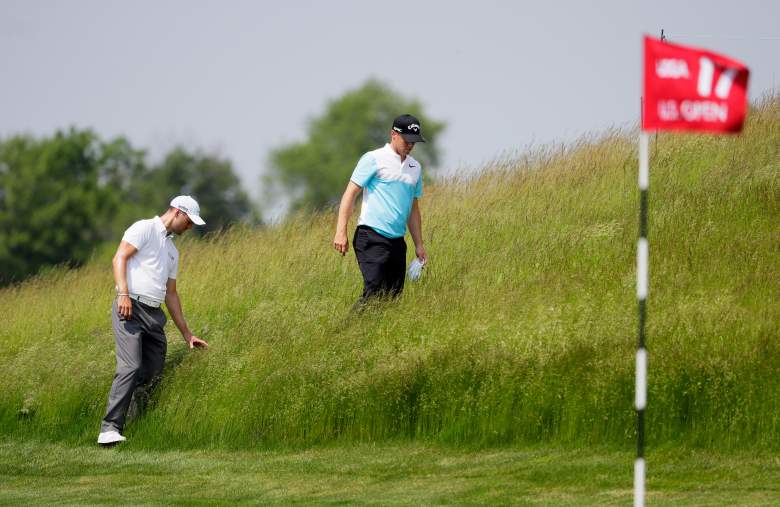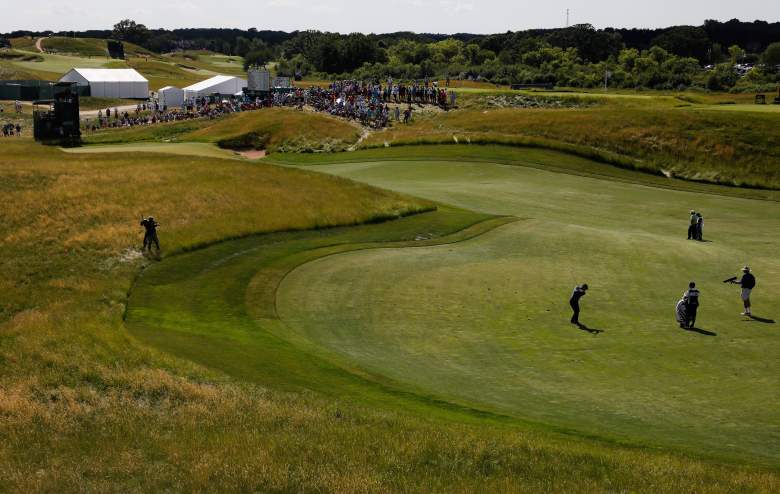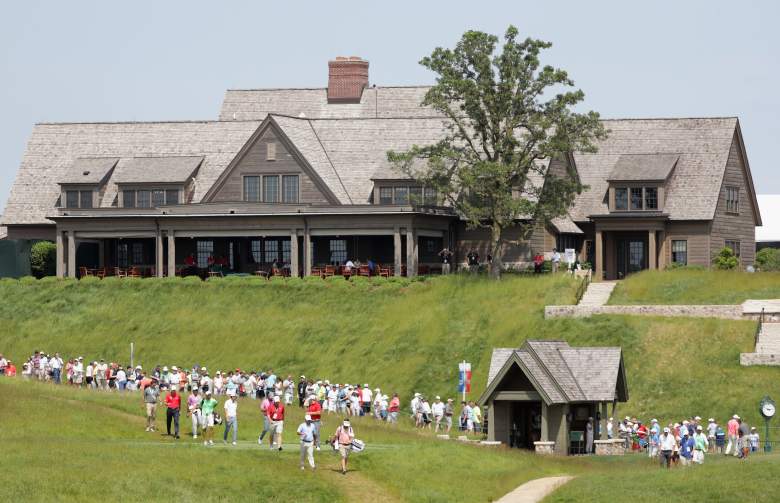
Alexander Noren of Sweden and Martin Kaymer of Germany look for a ball on the 17th hole during a practice round prior to the 2017 U.S. Open at Erin Hills Golf Course in Wisconsin on June 12. (Getty)
It’s been the word of the tournament so far. And expect to hear a lot more about it before the 2017 U.S. Open Championship concludes Sunday.
The fescue at Erin Hills Golf Course in Erin, Wisconsin has proven to frustrate a lot of golfers and has led to many of the top-ranked players being sent home early.
It’s drawn criticism from some golfers, and the USGA has even made strides to limit the length of it as it’s proven to be an added dimension of difficulty.
Here’s what you need to know:
1. The Fescue Is Supposed to Be a Staple of the Course
When Erin Hills opened in 2006, the tall fesue was thought the be one of the staple aspects of the course. It had been carefully nurtured over the season and completely mowed down in the winter time to preserve it.
In a post to the course’s website by Zach Reineking, he talks about taming the 145 acres of unmowed fine fescue on the course.
“These ares give Erin Hills its signature look, brown seed heads blowing in wind,” Reineking wrote. “Often, these areas are described as low maintenance or natural areas, but here is a significant amount of thought and effort put forth to create the desired look of fine fescue.”
So at the end of the season, all of it is completely mowed down in an effort to “encourage a new seed head” for the next year. It’s also mowed down to eliminate areas that were trampled down by golfers during the season.
Of course, cutting it leaves 18-22 inches of debris, so Erin Hills contracts a local farmer who baled it for hay, and then purchased a hay rake and baler from a farm after.
In the fall of 2014, Erin Hills compiled 3,480 bales of fescue from the course. That’s 138,000 pounds of plant material.
2. Golfers Complained About it, Rory McIlroy Defended it
As practice rounds on the course started, some golfers were outspoken about the impact the tall fescue would have on the U.S. Open field. Most notably, Kevin Na published a video of him trying to hit out of the fescue at the course.
In the video, Na said that the fescue is virtually unplayable and said it’s nearly impossible to find your ball if you hit it off the fairway and into the fescue.
Despite the troubles with the fescue, Na persevered and made the cut to play the weekend. He said he may have overreacted in the video after receiving criticism by others.
It was meant to be funny. I was just trying to show the fans the rough, and what we have inside the ropes, because people don’t get to see that close up. And I think it just blew up. … I think if I had laughed about it during the video instead of making it more like the news, I think people would have got a better kick out of it, maybe.
One of those who was critical of Na’s comments was Rory McIlroy, who said you should just pack up and go home if you have trouble with the fescue. He added at a press conference that the fairways at Erin Hills are the widest they’ve ever played before, so the fescue shouldn’t be an issue.
However, the fescue proved to have the last laugh at McIlroy, who failed to make the cut and was sent home early.
3. The USGA Cut Down Many Parts of the Grass Tuesday
Responding to criticism of the length of the fescue, the USGA made the decision to mow down some of the fescue on some holes at the course Tuesday.
The organization said that it decided to do so because heavy rains matted down much of the fescue in some areas and that made it incredibly more difficult than the course architects had envisioned. It added that only the fescue in high-traffic areas would be affected.
The USGA later said that the decision to cut the fescue didn’t have anything to do with complaints from golfers. Instead, it was part of the organization’s plan if there were wet conditions.
“When we made the decisions to modify a golf course, whether it’s green speeds, roughs, directions we’re mowing, how much water we’re applying or not applying. It’s not as if we don’t listen to feedback from players,” USGA Executive Director Mike Davis said at a press conference Wednesday. “But I will tell you in this case, it had nothing to do, absolutely zero to do with what the players were saying. We looked at some spots and we said this is simply not going to play properly.”
4. The Course Is Already the Longest Ever at the U.S. Open

Marc Leishman plays his shot on the 12th hole during the first round of the 2017 U.S. Open at Erin Hills on June 15. (Getty)
As if the fescue was enough of a challenge, the U.S. Open at Erin Hills is being played as the longest course ever for a major championship.
The par-72 course is playing at 7,741 yards, a nine-mile walk through the course. The maximum length that Erin Hills can actually play is over 8,000 yards, and the 2011 U.S. Amateur played even longer at 7,760 yards.
The 2016 U.S. Open at Oakmont measured 7,219 yards. The second-longest U.S. Open was at Chambers Bay in 2015 with a distance of 7,741 yards. But, as McIlroy noted, some of the fairways are the widest ever at a tournament at around 60 yards.
Last year at Oakmont, the fairways were between 28 and 32 yards, Golf Digest wrote, and 60 yards is twice the average PGA Tour fairway width.
5. Erin Hills Is Ranked in the Top 10 Public Courses in America

HARTFORD, WI – JUNE 13: A general view of the clubhouse during a practice round prior to the 2017 U.S. Open at Erin Hills on June 13, 2017 in Hartford, Wisconsin. (Photo by Streeter Lecka/Getty Images)
Erin Hills has been open for 11 years, and is ranked No. 9 on Golf Digest’s rankings of America’s Greatest Public Courses.
The publication wrote in its description of the course how the vision has changed from when it opened.
Despite the legend spread by many, Erin Hills wasn’t designed specifically to host a U.S. Open. Its original concept was to be a simple, affordable, lay-of-the-land layout that proved Mother Nature is indeed the best golf architect. The concept changed – some greens moved, one blind par 3 eliminated – as the quest for a U.S. Open grew. After trial runs hosting the 2008 U.S. Women’s Publinks and the 2011 U.S. Amateur, Erin Hills will host the 2017 U.S. Open, the first time the event has ever been in Wisconsin.
Erin Hills is ranked No. 42 on Golf Digest’s 100 Greatest Courses overall list.
The public are invited to play at the walking-only course, and open play begins for the 2017 season shortly after the U.S. Open concludes July 1.
Green fees are rather pricey, though. During the 2017 season, it will cost $280 to play while it’s $180 for active military members. The prices will go up in 2018, too. Green fees will sit at $295 for the season.
Then there’s also the caddie fee of $55 per player and a suggested minimum gratuity of $65 or more.







